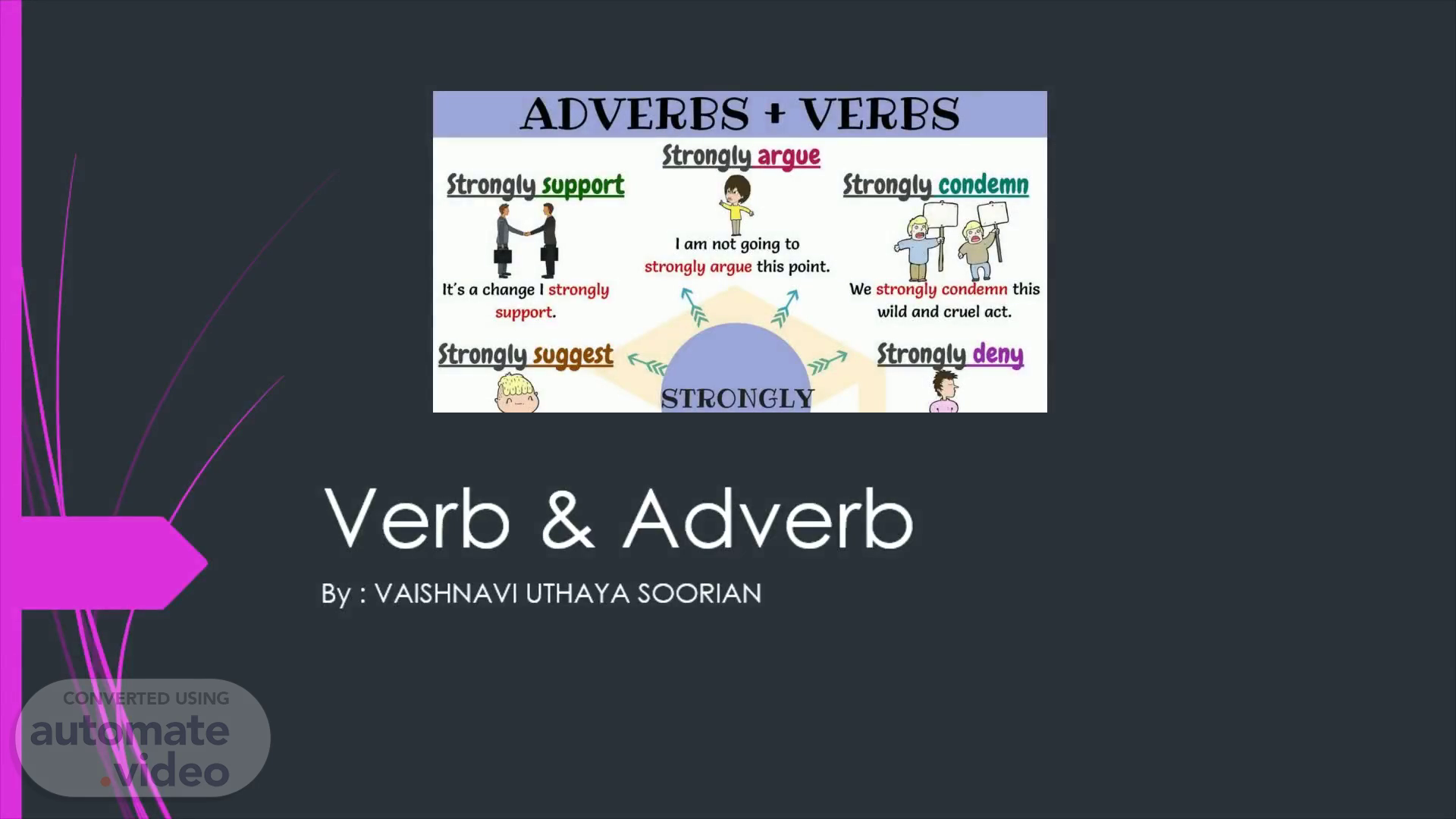Page 1 (0s)
Verb & Adverb. By : VAISHNAVI UTHAYA SOORIAN. ADVERBS + VERBS Strongly argue Strongly condemn Strongly support I am not going to strongly argue this point. It's a change I strongly support. Strongly suggest We strong y con emn this 47, wild and cruel act. ron I den TRONGL.
Page 2 (13s)
What is verb ????. A word used to describe an action, state, or occurrence, and forming the main part of the predicate of a sentence . such as hear , become , happen ..
Page 3 (33s)
There are 7 types of verbs :. Regular Verb. Irregular Verb. Linking Verb. Transitive Verb. Intransitive Verb. Finite Verb. Infinitive Verb.
Page 4 (44s)
Verbs rules :. If the subject is singular, the verb must be singular too. If the subject is plural, the verb must also be plural. When the subject of the sentence is composed of two or more nouns or pronouns connected by and, use a plural verb . Those verbs are: Act, feel, remain, appear, become, seem, smell, sound, grow, look, prove, stay, taste, turn . Some verbs in this list can also be action verbs. To figure out if they are linking verbs, you should try replacing them with forms of the be verbs..
Page 5 (1m 13s)
Verbs forms. There are up to five forms for each verb:.
Page 6 (1m 25s)
1.Root. The verb root is the same as the infinitive form but without the "to." For example:.
Page 7 (1m 38s)
Third-person Singular. Most verbs in English form the third-person singular by adding -s to the base form Verbs ending in - ch , -s, - sh , -x , or -z form the third-person singular by adding - es Verbs ending in a consonant + y (such as try ) form the third-person singular by changing the y to i and adding - es For example: ( sing s , give s , require s ). ( watch es , miss es , rush es , mix es , buzz es ). ( tri es )..
Page 8 (2m 2s)
Present participle verb form. The present participle of a verb is the form which ends in '- ing ‘. The verbs “dancing” in “He was dancing” and “crying” in “The baby is crying” are present participles . Eat – Eating Sleep – Sleeping Wait – Waiting Eating, sleeping and waiting are all present participles. Spelling rules With verbs that end in -e, we remove the -e and add - ing . For example, Drive – driving With most short one-syllable verbs, like stop, put, sit, we double the final consonant. For example, Stopping, putting, sitting..
Page 9 (2m 28s)
Past verbs. Past tense verbs refer to actions or events in the past. They can be regular verbs that simply end with a "d" or an " ed " or they can be irregular and change their spelling to show the past tense..
Page 10 (2m 47s)
Past participle. The past tense and past participle form is had . When do we use the past participle? The past participle is used in two main ways: to create past verb forms as an adjective.
Page 11 (3m 0s)
When the modal verb are used ????. For example:. Likelihood -should -must Possibility -could -may -might Ability -can -cannot Asking permission -can -may could Request -will -would -can could Suggestion/advise -should.
Page 12 (3m 17s)
What is Adverb????. a word or phrase that modifies or qualifies an adjective, verb, or other adverb or a word group, expressing a relation of place, time, circumstance, manner, cause, degree, etc. (e.g., gently , quite , then , there ). What is adverb describe? An adverb is a word used to modify a verb, adjective, or another adverb . An adverb usually modifies by telling how, when, where, why, under what conditions, or to what degree. An adverb is often formed by adding - ly to an adjective ..
Page 13 (3m 51s)
Adverbs rules. Adverbs Word Order Adverbs are usually placed after the verb : He speaks clearly . When there is an object, the adverb is usually placed after the verb + object : I put the vase carefully on the table. However, adverbs are never positioned between the verb and the object. I read the book quickly. - (Correct) I read quickly the book. - (Incorrect) Sometimes adverbs are placed at the beginning of a clause. Quickly, I changed my opinion..
Page 14 (4m 13s)
Adverbs forms. Most adverbs are formed by adding - ly to the end of the related adjective Exceptionally, words which end in - ble drop off the -e before - ly is added. So do the words true and due ..
Page 15 (4m 29s)
Adverbs Usage. An adverb is a word that describes or modifies verbs, adjectives , clauses, and other adverbs. We use it to give additional information about other words . There are three things to remember while using describing words. First, they usually give background information by telling the reader where, when, why, or how something happens ..
Page 16 (5m 8s)
Thank you.
